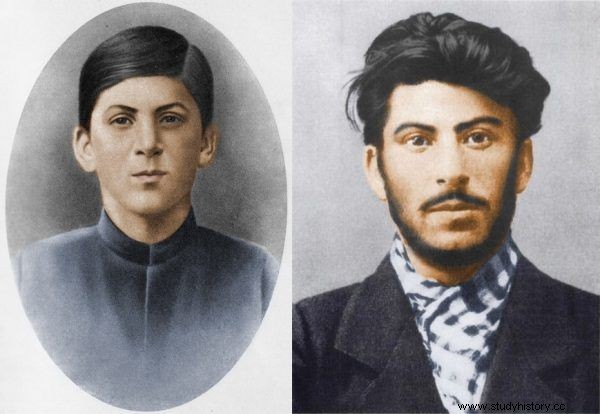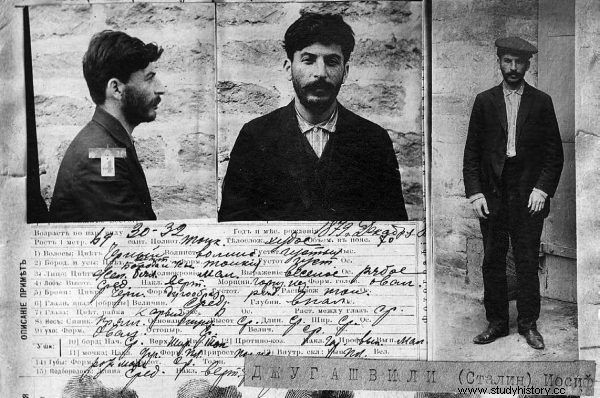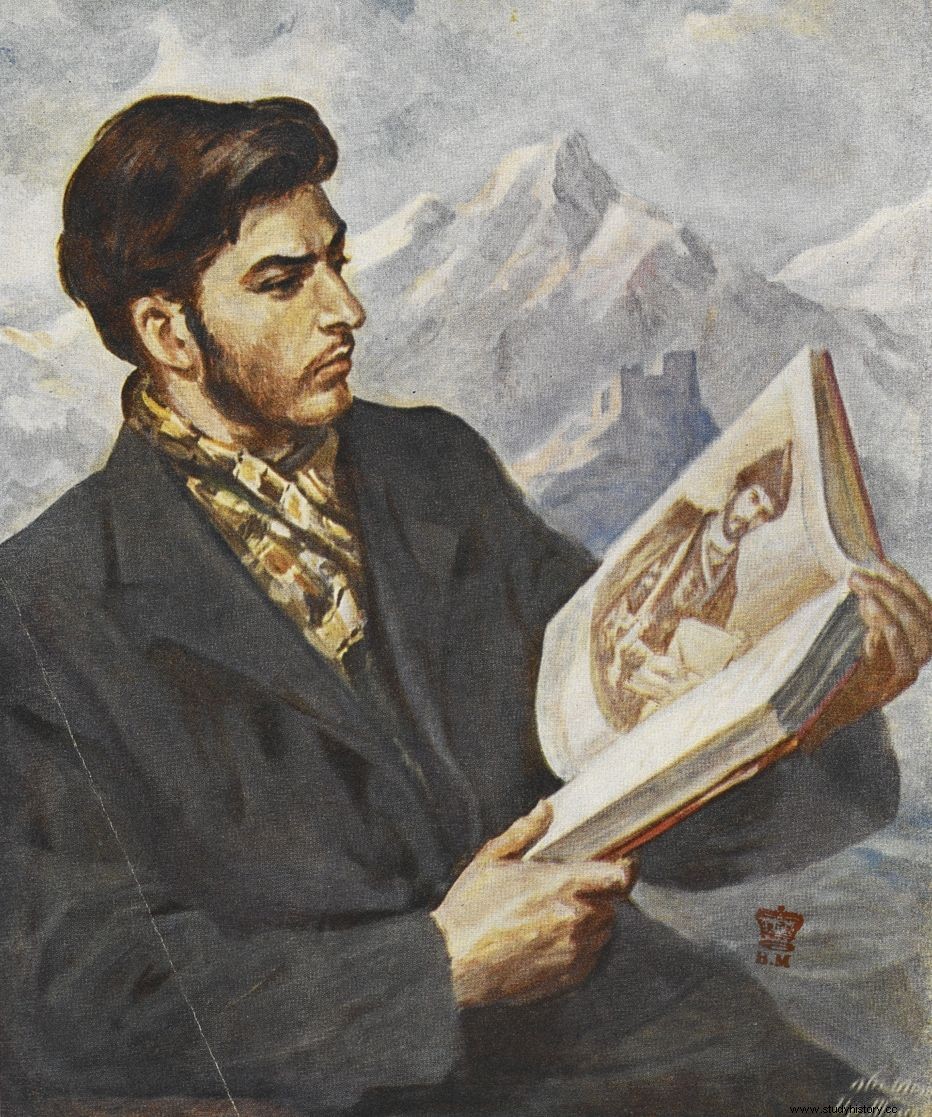Crimes against tens of millions of people cannot be justified. But you can at least try to understand them. Was Stalin a madman? An evil genius? And is it possible that it was more about the tonsils than the communist ideology?
The future wożd ' the Soviet empire from birth had health problems. Apart from the fact that his two toes were fused together on his left leg, little Soso caught a contagious disease twice in his infancy.
His parents feared he would share the fate of their two older brothers who died before the age of one. In his intention, they went on a pilgrimage to the church in Gori. A sheep sacrifice and the ordered mass may have helped. Ioseb survived, though he remained - in his mother's words - weak, gentle and frail .
Playing with death
Moments of real terror came in 1884, when Soso, who was less than six years old, contracted smallpox . The plague also hit the family of one of the Dzhugashvili friends. His three children died on the same day. But not little Joseb. However, until the end of his life, he had "beaks" on his face and hands.

In official photos of Stalin, it is in vain to look for even the slightest trace of smallpox in his childhood. All of them have been carefully retouched (source:public domain).
More than once, Stalin had to face the grim reaper. He also had malaria, and at the age of six or ten had an accident that resulted in left arm muscle atrophy and permanent disability. Though he complained that it made it difficult for him to dance, he should rather be grateful. A broken arm saved him from military service and possible death on the battlefields of World War I.
This is not the end, however. At twelve, Soso was hit by a speeding carriage which ran over his legs and seriously injured him . The victim recovered only after a few months in hospital. It wasn't long before Ioseb became seriously ill again, this time with pneumonia. He slipped out of death again One of his teachers wrote down.
As early as 1898, the future dictator asked the rector of his seminary to be released due to chest disease . He similarly explained his application for release from prison in 1902. He then complained of pains in his chest and increasing cough. The young revolutionist had symptoms of tuberculosis , but these problems have resolved with time.
In Siberian exile
Stalin was sent to exile in Siberia several times. The first time a local medical assistant treated his tooth with ... arsenic . The pain was gone, but a few other teeth fell out in the process. He had problems with caries for the rest of his life. The next time he was in a "prison without bars" Ioseb contracted typhus.

The stay in prison and the many years of exile to Siberia did not have a positive effect on the health of the future Soviet dictator. Picture from the book “Stalin. New biography ”(Znak Horyzont 2016).
But the more difficult moments were related to the last sentence, when he hit the Arctic Circle. He endured the harsh climate with difficulty, suffered from a persistent cough and was constantly ill. As summed up by Oleg Khlevniuk in his recent biography of wożdia USSR:
the tsarist government was incomparably more friendly to the inmates than the Stalinist dictatorship. If young Stalin had to survive the same number of arrests and deportations (...) in the Gulag he created, most likely he would not have survived at all .
What influence did all these accidents and diseases have on the psyche of Stalin? It is known that he was ashamed of his inoperative arm, fused fingers and smallpox marks, which he ordered to powder and retouch in photographs. His unfitness for military service, which was found in 1917, struck his pride a lot. But that certainly doesn't explain the great terror.

As a child, Stalin had an accident that led to the atrophy of the muscles of his left hand. Therefore, he certainly was not able to read books in the way presented in this propaganda drawing (source:public domain).
A sick dictator
After the Bolsheviks took power, Stalin's health deteriorated rather than improved. Though he could enjoy the abundance of food, therapeutic baths, a suburban dacha, and a vacation in the south of the country, the destructive lifestyle was decisive.
The dictator did not like exercise and active rest and spent most of his time sitting on strenuous work. There was also gluttony, smoking and huge amounts of alcohol drunk . No wonder then that Stalin complained of recurring ailments such as tonsillitis, digestive problems, rheumatism, sciatica, arthritis, muscle aches, regular flu and much more.
This article has more than one page. Please select another one below to continue reading.Attention! You are not on the first page of the article. If you want to read from the beginning click here.
Dzhugashvili's letters clearly show that his health was often the cause of bad mood and anger. In early 1937, another wave of terror coincided with tonsillitis wożdia . Of course, it is impossible to point to a direct cause-and-effect relationship here, but the sore throat and despot's fever could have influenced the fate of many victims.

The article is based on the book by Oleg Khlevniuk entitled “Stalin. New biography ”(Znak Horyzont 2016).
Stalin closely supervised the course of repression, approving death sentences, rejecting or accepting requests for grace, and setting lower limits for those arrested. It is not hard to imagine that the pain-infuriated dictator treated some "enemies of the people" with even greater severity than usual .
During the years of the great terror and World War II, Stalin ceased his summer trips to the south, and hard work had an additional impact on his health. After 1945, however, he spent more and more time at his dacha near Moscow, and his holidays were extended to over four months. However, it did not help much.
In 1946 he was diagnosed with hypertension, atherosclerosis, weakened heart muscle and viral hepatitis. Despite the doctors' recommendations, he was unable to change his lifestyle, although shortly before his death, quit smoking after more than fifty years .

Jury of defendants in the second Moscow trial. A sore throat and a fever could make Stalin treat his victims even more ruthlessly (source:public domain).
The White Death
In 1952, Stalin's personal physician, Prof. Vladimir Vinogradov stated that his patient's health was so poor that ordered him to completely stop all activities . This infuriated the dictator, who would not part with his full powers and hoped to live for many more years. When he got acquainted with the doctor's diagnosis, he reportedly roared - as Khrushchev said - Put him in chains, in chains! .
Paranoid wożd ' smelled another conspiracy:Kremlin doctors . They were to be Jewish agents of American intelligence or to act on behalf of the British services, and their purpose was allegedly to weaken the civil and military authorities of the USSR. Incorrect diagnoses and poorly chosen therapies were to be an attempt on the life and health of generals and party dignitaries.
Nine recognized doctors were arrested and tortured for participating in the conspiracy, after which two of them died. An anti-Semitic campaign has been launched , many doctors, scientists and laboratory workers of Jewish origin were dismissed from work. The arrests also affected doctors unrelated to the original accusation. Only Stalin's death as a result of a stroke ended this absurd case and the anti-Semitic campaign, and the survivors of torture were released.
A sick man ruled the state
An autopsy showed severe damage to the arteries in wożdia brain and numerous cysts, especially in the frontal lobes resulting from hypertonia and atherosclerosis. It is likely that they caused the changes in Stalin's character, observed in the last years of his life by family members and associates. The intensification of innate despotism and cruelty was felt by all.

With age, Stalin's health deteriorated more and more, but his paranoia was getting better. The photo shows the Soviet dictator with his companions during the ceremony in January 1947. Picture from the book “Stalin. New biography ”(Znak Horyzont 2016).
Oleg Khlevniuk cites the opinion of Alexander Myasnikov, one of the doctors summoned to the dying Stalin:
I believe that Stalin's cruelty and suspicion, his fear of enemies and his loss of ability to judge people and events, his extreme stubbornness - it was all, to some extent, the result of atherosclerosis in the brain (or rather, that atherosclerosis aggravated these features).
Basically the state was ruled by a sick man. The sclerosis of the blood vessels in Stalin's brain developed slowly over many years. Also, softened areas that arose much earlier were discovered there. Even the most faithful of the faithful, Vyacheslav Molotov, admitted that Stalin did not fully control himself at the end of his life . However, it remains an open question to what extent the dictator's diseases influenced his criminal policy.
Bibliography:
- Jörg Baberowski, Stalin. Absolute terror , Prószyński i S-ka, Warsaw 2014.
- Oleg Khlevniuk, Stalin. New biography , Znak Horyzont, Krakow 2016.
- Yakov Rapoport, Stalin's last crime. 1953:The conspiracy of Kremlin doctors , Erica, Warsaw 2011.
- Simon Sebag Montefiore, Stalin. The young years of the despot. Before the court of the Red Tsar was established , Świat Książki, Warsaw 2008.
